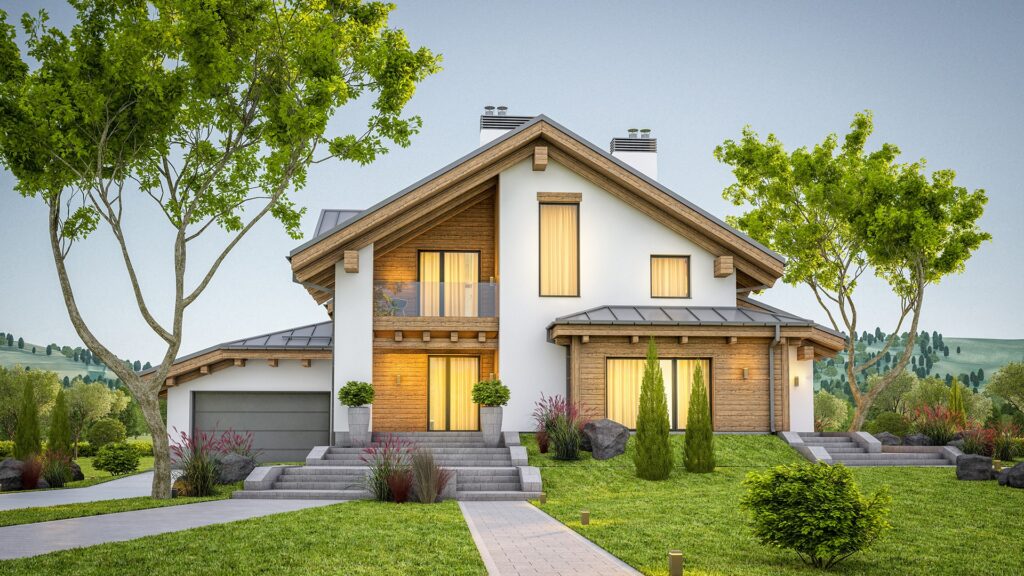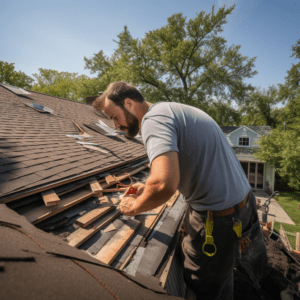Roofing designs have evolved over time, reflecting the demands of different contexts and cultural preferences. This article explores a range of unique roofing designs, examining their historical roots and contemporary applications. By considering various factors such as aesthetics, environmental sustainability, and technological advancements, readers will gain insights into innovative solutions for their own roofing needs. From minimalist and eco-friendly options to rooftop gardens and geometric patterns, this comprehensive exploration aims to inspire practical yet creative approaches to roof design.
Key Takeaways
- Copper roofs offer durability, longevity, and attractive patina.
- Clay tiles provide distinct texture and excellent thermal insulation.
- Slate roofs provide natural elegance with a smooth surface and varying shades.
- Green roofs improve energy efficiency and add visual interest.
Historical Roofing Designs
Historical roofing designs have played a significant role in the architectural development and cultural identity of various civilizations throughout time. These designs were not only functional, but also reflected the unique characteristics and aesthetics of each civilization.
One example of a historical roofing design is the thatched roof. Thatched roofs were commonly used by ancient civilizations such as the Egyptians, Greeks, and Romans. They were made from local vegetation such as straw, reeds, or grasses and provided excellent insulation and protection against the elements. Thatched roofs were lightweight yet durable, making them suitable for different climates.
Another notable historical roofing design is the tiled roof. Tiled roofs became popular during ancient times in civilizations like China, Greece, and Rome. The tiles were typically made from materials such as clay or slate and were arranged in an overlapping pattern to create a watertight seal. Tiled roofs offered durability and resistance to fire, making them practical choices for long-lasting structures.
Modern and Minimalist Roofing Designs
This paragraph will introduce a discussion on modern and minimalist roofing designs, specifically focusing on the key points of sleek and simple aesthetics and contemporary roofing trends. Modern roofing designs often prioritize sleek and simple aesthetics, characterized by clean lines, minimal ornamentation, and a focus on functionality. This aesthetic is achieved through the use of materials such as metal, glass, and concrete, which provide a streamlined appearance. Additionally, contemporary roofing trends involve innovative design elements such as flat roofs with integrated solar panels or green roofs that promote sustainability.
Sleek and Simple Aesthetics
One characteristic of sleek and simple aesthetics in roofing designs is the use of clean lines and minimalist materials. The emphasis is on creating a streamlined and uncluttered appearance that enhances the overall architectural design of a building. Clean lines refer to straight, sharp edges that create a sense of order and simplicity. This can be achieved through the use of flat or low-pitched roofs, which provide a smooth and uninterrupted surface. Minimalist materials further contribute to this aesthetic by focusing on functionality rather than ornamentation. Common materials used in sleek and simple roofing designs include metal, concrete, glass, and wood. These materials are often chosen for their durability, ease of maintenance, and ability to seamlessly integrate into different architectural styles. Overall, sleek and simple aesthetics in roofing designs offer a timeless appeal that complements modern architecture while providing practical benefits such as energy efficiency and long-term sustainability.
Contemporary Roofing Trends
Contemporary architectural trends have witnessed a shift towards innovative and sustainable approaches in roofing, encompassing the integration of green technologies and the use of unconventional materials. One prominent trend is the incorporation of solar panels into roofing systems, allowing buildings to generate renewable energy. This not only reduces dependence on traditional power sources but also lowers electricity costs over time. Additionally, there is an increasing focus on using unconventional materials for roofs, such as recycled or repurposed materials like reclaimed wood or metal sheets. These materials not only add unique aesthetic value to buildings but also contribute to sustainability efforts by reducing waste and resource consumption. Furthermore, contemporary roofing designs often prioritize energy efficiency by incorporating proper insulation and ventilation systems that minimize heat loss or gain. This ensures comfortable indoor environments while reducing energy usage for heating or cooling purposes. Overall, these trends reflect a growing emphasis on sustainable and practical solutions in modern architecture.
Eco-Friendly Roofing Designs
The use of sustainable materials in roofing design is an important consideration for environmentally conscious individuals and organizations. By opting for materials that are sourced responsibly and have a low carbon footprint, such as recycled metal or reclaimed wood, the environmental impact can be minimized. Additionally, energy-efficient roofing options, such as cool roofs or green roofs, can help reduce energy consumption by providing insulation and reducing heat transfer. These choices not only benefit the environment by reducing waste and conserving resources but also contribute to long-term cost savings for homeowners and businesses.
Sustainable Materials Used
Utilizing sustainable materials in roofing designs has become a key focus in the construction industry. The use of sustainable materials not only reduces the environmental impact but also offers several practical benefits. One such material is recycled metal, which is commonly used for metal roofs. Recycled metal roofs are highly durable, lightweight, and have a long lifespan. Another sustainable option is clay or concrete tiles made from natural materials. These tiles are resistant to fire and can withstand extreme weather conditions. Additionally, wood shingles made from sustainably sourced wood are gaining popularity due to their aesthetic appeal and renewable nature. Finally, green roofs that incorporate vegetation provide insulation, reduce stormwater runoff, and improve air quality. Incorporating these sustainable materials into roofing designs helps promote eco-friendly practices while offering practical advantages in terms of durability and energy efficiency.
Energy-Efficient Roofing Options
Energy-efficient roofing options play a crucial role in reducing energy consumption and promoting sustainability in the construction industry. These options are designed to minimize heat transfer, improve insulation, and optimize natural lighting, resulting in reduced reliance on artificial heating, cooling, and lighting systems. One such option is cool roofs, which have high solar reflectance and thermal emittance properties to minimize the absorption of solar radiation and reduce heat transfer into the building. Green roofs are another energy-efficient option that involves covering the roof with vegetation to provide additional insulation and reduce stormwater runoff. Additionally, insulated metal roofing systems offer superior thermal performance by combining a durable metal surface with a layer of insulation underneath. Energy-efficient roofing options not only contribute to environmental sustainability but also help lower energy costs for building owners while creating more comfortable indoor environments.
Benefits for the Environment
One of the positive outcomes for the environment is that energy-efficient roofing options contribute to reduced greenhouse gas emissions. Energy-efficient roofs are designed to reduce heat transfer, leading to lower cooling and heating costs. These roofs employ various materials and techniques such as reflective coatings, insulation systems, and ventilation strategies to minimize energy consumption. By reducing the need for air conditioning or heating, these roofs can significantly decrease carbon dioxide emissions from power plants. Additionally, energy-efficient roofing options can also extend the lifespan of a building’s HVAC system by reducing its workload. The overall reduction in energy demand not only leads to cost savings but also helps mitigate climate change by decreasing reliance on fossil fuels while promoting sustainability in buildings.
Rooftop Garden Designs
Rooftop garden designs offer an innovative approach to utilizing underutilized urban spaces and promoting sustainability in cities. These unique designs involve transforming rooftops into green spaces, providing numerous benefits for both the environment and the community. The use of rooftop gardens can help mitigate the heat island effect by reducing surface temperatures and improving air quality through the absorption of carbon dioxide and other pollutants.
One practical aspect of rooftop garden design is the selection of appropriate plant species that can thrive in these elevated environments. Factors such as wind exposure, limited soil depth, and water availability need to be considered when choosing plants. Additionally, proper irrigation systems must be implemented to ensure adequate moisture for plant survival.
Rooftop gardens also contribute to stormwater management by reducing runoff and easing the burden on existing drainage infrastructure. Green roofs retain rainwater, preventing it from entering storm drains or causing flooding downstream.
Furthermore, these gardens provide recreational spaces for residents in densely populated areas where open green space may be limited. They create opportunities for leisure activities such as gardening, picnicking, or simply enjoying nature within city limits.
Geometric Roofing Designs
The previous subtopic explored the concept of rooftop garden designs, which utilize rooftops as functional green spaces. In this section, we will shift our focus to geometric roofing designs. Geometric roofs are characterized by their unique and intricate shapes, adding an aesthetic appeal to buildings while also serving functional purposes.
One popular geometric roofing design is the pyramid roof. This type of roof features four equal triangular sides that converge at a single point on top, creating a symmetrical shape. Pyramid roofs are not only visually striking but also provide structural stability by evenly distributing the weight load.
Another common geometric roofing design is the dome roof. Dome roofs have a rounded or curved shape and often feature a circular base. They can be constructed using various materials such as glass or metal and offer excellent resistance against wind and snow loads due to their streamlined form.
Lastly, there are butterfly roofs, which resemble the wings of a butterfly when viewed from above. Butterfly roofs consist of two slopes that meet at a central valley, creating a distinct V-shape in the middle. This design allows for increased natural light penetration and efficient rainwater collection.
Geometric roofing designs offer architects and building owners creative opportunities for enhancing visual appeal while ensuring structural integrity. By incorporating these unique roof shapes into their designs, they can create distinctive buildings that stand out in terms of both aesthetics and functionality.
Unique Roofing Materials and Textures
To explore unique roofing materials and textures, it is important to consider the wide range of options available in architectural design. Roofing materials play a crucial role in both the functionality and aesthetics of a building. One unique material that can be utilized is copper. Copper roofs offer durability, longevity, and an attractive patina that develops over time. Additionally, clay tiles provide a distinct texture to roofs while also offering excellent thermal insulation properties. The use of slate as a roofing material provides a natural elegance with its smooth surface and varying shades. Another option for creating unique textures is the implementation of green roofs, which involve covering the roof with vegetation. This not only adds visual interest but also improves energy efficiency by reducing heat absorption and enhancing insulation.
Furthermore, synthetic materials such as polymer-based shingles or metal panels can be utilized to create unconventional textures on roofs. These materials are lightweight yet durable, making them suitable for various architectural designs.
Creative Roofing Shapes and Patterns
The use of unique roofing shapes and patterns can add an aesthetic appeal to a building while also serving functional purposes. Creative roof designs can enhance the architectural style and character of a structure, making it stand out from others in its surroundings. These designs often involve intricate geometries and unconventional forms that challenge traditional roofing practices.
One popular creative roofing shape is the butterfly roof, which features two inward-sloping surfaces meeting at a central peak. This design allows for increased natural light and ventilation, as well as rainwater collection in a central gutter system. Another example is the mansard roof, characterized by steeply sloping sides and a flat or gently sloping top. The mansard design maximizes interior space by creating additional living areas within the attic.
In addition to unique shapes, creative roofing patterns can be achieved through various materials and techniques. For instance, using different colored tiles or shingles arranged in geometric patterns can create visually striking effects on the roof’s surface. Alternating textures such as smooth and rough tiles can also add depth and dimension to the overall design.
When considering creative roofing shapes and patterns, it is important to ensure they are compatible with local climate conditions and structural requirements. Engaging professional architects or designers who specialize in innovative roof designs will help ensure that both aesthetics and functionality are successfully balanced.
High-Tech Roofing Innovations
High-tech roofing innovations have revolutionized the construction industry by introducing advanced materials and technologies that enhance the durability, energy efficiency, and performance of roofs. These innovations have significantly improved the overall quality and longevity of roofs, providing homeowners with more reliable and cost-effective solutions.
One such innovation is the use of solar panels integrated into roofing materials. These photovoltaic (PV) systems capture sunlight and convert it into usable electricity, reducing dependence on traditional energy sources and lowering utility bills. Additionally, these solar panels can be seamlessly incorporated into various roofing designs without compromising their functionality or aesthetic appeal.
Another high-tech roofing innovation is the development of cool roof coatings. These coatings are designed to reflect sunlight rather than absorb it, reducing heat transfer into buildings and minimizing the need for air conditioning. By keeping buildings cooler in hot climates, cool roof coatings contribute to significant energy savings while enhancing occupant comfort.
Furthermore, advancements in material science have led to the introduction of lightweight yet durable roofing materials such as composite shingles made from recycled plastics or rubber. These materials offer superior resistance against weather elements while being environmentally friendly.
Energy-Efficient Roofing Solutions
Energy-efficient roofing solutions are designed to minimize heat transfer into buildings and reduce energy consumption. These innovative designs employ various strategies to achieve optimal thermal performance. One common approach is the use of reflective or cool roofs, which have high solar reflectance and thermal emittance properties. Reflective roofs reflect a significant portion of sunlight, reducing the amount of heat absorbed by the building. This results in lower cooling requirements during hot weather, leading to reduced energy consumption. Another strategy involves the installation of insulation materials beneath the roof surface. Insulation helps to prevent heat gain in summer and heat loss in winter, improving overall energy efficiency.
Additionally, green roofs are gaining popularity as an effective energy-efficient roofing solution. Green roofs consist of a layer of vegetation that provides insulation and reduces the urban heat island effect by absorbing solar radiation and releasing it as latent heat through evapotranspiration. This reduces both heating and cooling demands within buildings.
Moreover, newer technologies such as phase change materials (PCMs) are being integrated into roofing systems to enhance their energy efficiency. PCMs absorb excess heat during the day and release it at night when temperatures drop, reducing reliance on air conditioning systems.




